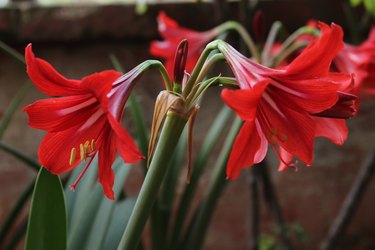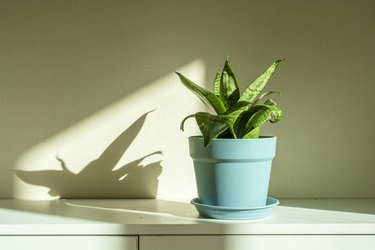When you're adopting a cat, make sure you inspect your home for poisonous plants before your new kitty's arrival. An easy way to check if a plant is safe is to review the ASPCA list of toxic plants. Removing poisonous plants from your cat's environment can help prevent illnesses, and expensive vet bills — and even save your kitty's life.

Video of the Day
Toxic plants to cats
Whether flowers are indoors in a vase, or outside as decorative landscaping, ingestion of toxic flowering plants can cause a host of problems for cats. Ailments include kidney failure, liver damage, problems with the nervous system, abdominal pain –– and death. Poisonous flowering plants to avoid include hyacinth, amaryllis, tulips, paper white, daffodils, narcissus, azalea, chrysanthemum, cyclamen, and carnations.
Video of the Day
There are plenty of beautiful blooms you can still enjoy while keeping your cat safe. Non-toxic flowering plants include African violets, petunias, garden marigolds, phalaenopsis orchids, and zinnias. Sunflowers are a great option, too. The ASPCA has a list of dozens of non-toxic plants to choose from.
Harmful holiday plants for cats
Holiday plants can add a festive flair, however, many are extremely dangerous if consumed by cats. It's best to avoid members of the lily family, as so many are poisonous. Even just one bite of any part of the Easter Lily can cause kidney failure –– and death –– if not treated quickly.
Calla lily, (which despite the name is not a member of the lily family) is toxic, too. Calla lilies contain insoluble calcium oxalate. If your cat chews into part of the plant, it can release crystals, causing tissue penetration and irritation to the mouth and gastrointestinal tract.
Other poisonous holiday plants to avoid include holly and mistletoe. You'll want to avoid poinsettia plants too. Although they're not specifically toxic, they can cause intestinal upset, and the sap can cause irritation to a cat's mouth and stomach. If you need to add holiday greenery, consider keeping your cat safe by decorating your home with a Christmas cactus, red roses (with thorns removed, just to be safe), or an array of other non-toxic plants.

Toxic houseplants to cats
The Sago palm, kalanchoe, aloe, philodendron, and snake plant are common house plants that are toxic to cats. The cycasin found in Sago palm can cause liver damage, liver failure, and death. Eating an aloe or snake plant can cause vomiting and diarrhea. If your kitty consumes a philodendron, it can cause painful swelling of their mouth, tongue and lips. Cane palms, spider plants and Boston ferns are a few good alternatives if you're searching for non-toxic indoor plants.
Poisonous plants in the kitchen
Plants that we consume in the kitchen may be fine for us to eat, but when it comes to cats, there are a few they should definitely avoid. Onions are toxic and can cause vomiting, a breakdown of red blood cells, blood in urine, weakness, and a high heart rate. Parsley can cause dermatitis and oregano can cause vomiting and diarrhea. If you grow your own tomatoes, be sure your cat doesn't eat the leaves as they can cause a host of ailments including severe gastrointestinal upset, depression, weakness, dilated pupils, and a slow heart rate. Grapes, raisins and avocados are toxic to cats, so be sure to keep those goodies off-limits, too.
Cat poisoning symptoms
Ingesting poisonous plants can have a large variety of symptoms depending on the plant and the amount consumed, so be sure to keep an eye on your cat's behavior. For example, oleander contains cardiac glycosides and can cause drooling, abdominal pain, diarrhea, colic, depression, and death. Dieffenbachia, also known as giant dumb cane, contains insoluble oxalate crystals and causes oral irritation, drooling, and difficulty swallowing. Other symptoms you may notice if your cat eats a poisonous plant include difficulty breathing, skin irritation, shivering, slow heart rate, loss of appetite, or low blood pressure.

Planning ahead for an emergency
One way you can help your cat stay healthy is by monitoring your cat's normal behavior so that when they start acting differently, you'll be able to notice the difference. For example, you should know the normal color of your cat's gums. Often, a cat's gums should be a shade of pink, rather than pale, but a cat could also have a shade of gray or black gums and be healthy too, depending on their pigment. You should also know your cat's normal activity level, litter box behavior and appetite.
Even after you think you've removed all of the toxic plants in your cat's surroundings, it's smart to have the number of a poison hotline and your veterinarian readily available, just to be extra safe. It's easy to display emergency phone numbers on your refrigerator, and you can carry an extra copy of them in your wallet, too. If you notice any symptoms of poisoning, immediately call your veterinarian, the Pet Poison Helpline or the ASPCA Animal Poison Control Center to determine the best next steps to take.